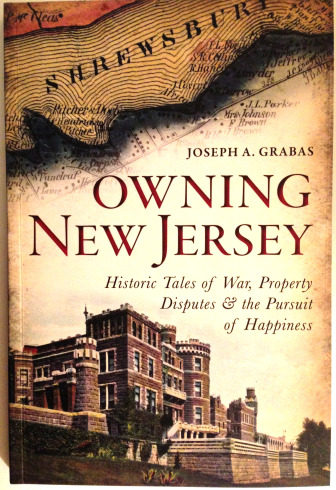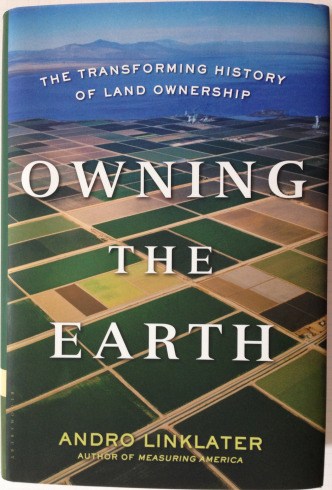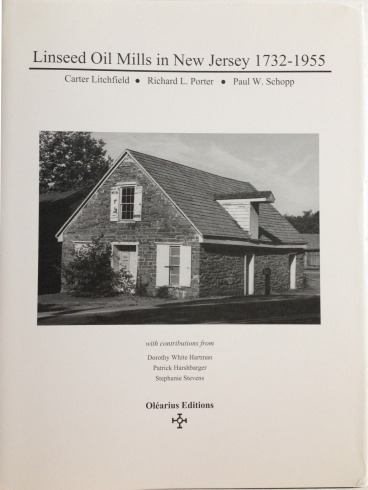In My Library: Owning New Jersey, Mapping New Jersey, Owning the Earth and New Jersey Linseed Oil Mills
 Owning New Jersey; Historic Tales of War, Property Disputes & the Pursuit of Happiness
Owning New Jersey; Historic Tales of War, Property Disputes & the Pursuit of Happiness
by Joseph A. Grabas, published by The History Press, 2014
What a great name for a book. I’ve wanted to own this book for decades, even though it did not exist until now. Joseph Grabas is a well-known figure among New Jersey historians, for his ability to take what he has learned from his many years as a title searcher and turn it into fascinating New Jersey history. He’s done a beautiful job of showing how interrelated land ownership and politics can be, and how those systems have influenced New Jersey history right from its very beginning. It’s also a very readable book. It is easy to overlook how much we can learn from old records—records that seem to be dry and uninteresting, unless an inquiring mind like Mr. Grabas takes a close look at them. Then they reveal great human dramas, both comedic and tragic. This book has much to teach us.
 Owning the Earth; The Transforming History of Land Ownership
Owning the Earth; The Transforming History of Land Ownership
by Andro Linklater, published by Bloomsbury, 2013
I’ve already got one of Mr. Linklater’s books–Measuring America, a fascinating look the way townships were established in our country when it was new, and the consequences of decisions about how to measure them. In this book, Owning the Earth, Mr. Linklater has gone way beyond that to the impact of land ownership on world history, and it has a surprisingly big one. Going all the way to the feudal era when all the land in a country belonged to the monarch and got loaned out to vassals, Linklater shows how the change from the feudal system to commodification of the land had a huge impact on how we live. He gives us a new look at the proprietary system in North America, and how it was doomed from the start. Fascinating book.

Linseed Oil Mills in New Jersey, 1732-1955
by Carter Litchfield, Richard L. Porter and Paul W. Schopp, published
Many years ago I met Carter Litchfield when he was researching this book. He was charming, curious and kind. Some time afterwards, I learned of his untimely death, before his great undertaking could be finished. Fortunately, he had some very good friends who took up the task and brought it to completion. This is a lovely book, just packed with interesting information, and Hunterdon County has one of the biggest chapters, with a long list of linseed oil mills located all over the county. Generally, wherever there was a linseed oil mill there were also other types of mills (grain, flour, plaster, and sawmills), so this book really covers a larger subject than linseed oil mills.
I have mentioned this book before, but failed to give it review status. Sadly, it is not available for purchase, unless you are a member of the Society for Industrial Archeology. You can buy a copy at their website. If you want the book enough to join the Society, act fast—their book offer ends at the end of this year, and only 200 copies were printed. Fortunately, Paul W. Schopp, one of the authors, saw to it that libraries and historical societies in the counties found in the book got a copy. It is an excellent book, and worth going out of your way for.
Nova Caesarea: A Cartographic Record of the Garden State, 1666-1888
by John Delaney, Princeton University, 2014
Caesarea is the old Roman name for Jersey, so Nova Caesarea means New Jersey. This book has been in the works for quite awhile now, and is finally ready for delivery. There are two versions, and of course I had to get the deluxe one, the one that weighs – I kid you not — ten pounds. That’s not a book; that’s statuary. I haven’t gotten my copy yet, so I can’t really review it. But I sure hope it arrives soon. It’s author, John Delaney, is the curator of the Maps Collection at Princeton University, and he has assembled all the maps that matter to New Jersey in this one publication. It is truly the sine qua non.
To see the actual maps shown in the book, especially those rare earliest ones, visit the exhibition at the Princeton Firestone Library. And if you’re hungry for more, tomorrow at 3 pm. in 101 McCormick Hall on the university campus, Dr. Maxine Lurie will talk on “A New Jersey Dozen: Maps That Changed/Defined the State.” The exhibit will close sometime before January 25, 2015. Don’t miss it.
Gary Muyskens
November 4, 2014 @ 12:04 am
I am looking for original documents/maps etc concerning a Amos Ogden(known as Captain Amos) of Mississippi Mandamus fame. He supposedly had a home/mill in Tewksbury Township…does a map showing this mill exist? Are there any old lithos/etchings etc of said mill?
this is info someone else had on the property
Date: 1763
Citation: D. Stanton Hammond, Early Landowners of Hunterdon County (Trenton, New Jersey: Genealogical Society of New Jersey, 1978), “Hunterdon County, Sheet E, Grid A-3.” Hereinafter cited as Early Landowners of Hunterdon County.
Citation Memo: “New Bromley” Andrew Leake (Mtgr Bk 1, page 351) 1762, 245 acres, Capt Amos Ogden and Michael Van Court (Mtgr 1, page 351) 1763.
Note: Joint ownership with Michael Van Court, at the fork of Rockaway Creek, probable location of the grist mill that Capt. Amos owned in this county.
I was told the site is now a golf course, and have read that a family named Pickle may have subsequently owned the mill, as it is I have NO documents, deed/map/drawing of his existence there and New Jersey has the most tight-fisted policy about obtaining copies I have seen yet. I live in Michigan and never get out of state, Any chance you can dredge me up something?